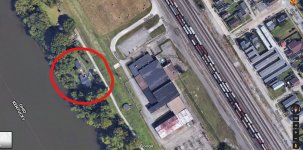deepbeep
Full Member
Well, I might as well be the first! lol
I will give an abbreviated version of the story......well, something like this anyway:
In the 1760's the French held possession of fort Duesquine, which later became fort Pit in Pittsburgh. George Washington was leading a company of 2000 British troupes from the east to attack the fort. The British held up at Turtle Creek for the night.
Indian scouts reported to the French that an attack was coming. The french loaded one ton of gold which was to be the french payroll onto 10 pack horses and sent them west along the Great Trail. They were to head to Bolivar where there was a block house for shelter and provisions. That location later became the location of Fort Laurens.
The British were successful in overthrowing the fort and learned of the escape with the gold. Four days out of Pittburgh, the British were catching up to the French, so the Frenchy burried the gold to avoid it getting into British hands. It was reportedly burried at the fork of 3 springs. One mile to the west of that location a rock was placed in the fork of a tree.
There was only one survivor of the ensuing battle, a fellow by the name of Le'sour. (sp?). In 1820 or so, a diary of the (by then deceased) Le'sour telling the entire story was found.
I lived along side the Great Trail, and researched this story for years.My notebook of "facts" mostly substantiated, was over 100 pages long. It has been researched by many, and plenty of springs in that area dug up, but nothing ever found...Except for one thing that is.
A lady I met while researching this....showed me a rock, wrapped in a towel, and placed in a shoe box.
"Her grandfather hit it with an axe while splitting fence posts".
I tried.........and finely learned to live with the failure! lol......Let me know when you find it.
Tim
I will give an abbreviated version of the story......well, something like this anyway:
In the 1760's the French held possession of fort Duesquine, which later became fort Pit in Pittsburgh. George Washington was leading a company of 2000 British troupes from the east to attack the fort. The British held up at Turtle Creek for the night.
Indian scouts reported to the French that an attack was coming. The french loaded one ton of gold which was to be the french payroll onto 10 pack horses and sent them west along the Great Trail. They were to head to Bolivar where there was a block house for shelter and provisions. That location later became the location of Fort Laurens.
The British were successful in overthrowing the fort and learned of the escape with the gold. Four days out of Pittburgh, the British were catching up to the French, so the Frenchy burried the gold to avoid it getting into British hands. It was reportedly burried at the fork of 3 springs. One mile to the west of that location a rock was placed in the fork of a tree.
There was only one survivor of the ensuing battle, a fellow by the name of Le'sour. (sp?). In 1820 or so, a diary of the (by then deceased) Le'sour telling the entire story was found.
I lived along side the Great Trail, and researched this story for years.My notebook of "facts" mostly substantiated, was over 100 pages long. It has been researched by many, and plenty of springs in that area dug up, but nothing ever found...Except for one thing that is.
A lady I met while researching this....showed me a rock, wrapped in a towel, and placed in a shoe box.
"Her grandfather hit it with an axe while splitting fence posts".
I tried.........and finely learned to live with the failure! lol......Let me know when you find it.
Tim


 , I'm gonna go lookin for it.... i think the only reason people dont find gold to often is cause they dont try hard enough
, I'm gonna go lookin for it.... i think the only reason people dont find gold to often is cause they dont try hard enough  . Ill look till I'm 80, then use the money to extend my life so i can enjoy my riches.... 8)
. Ill look till I'm 80, then use the money to extend my life so i can enjoy my riches.... 8)










